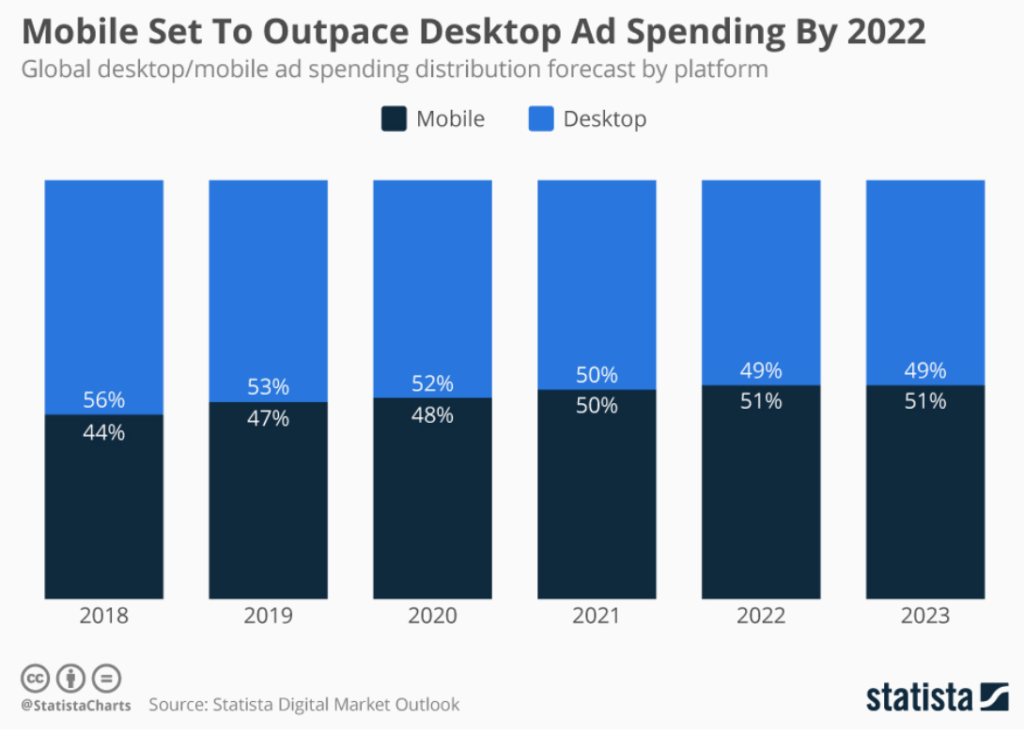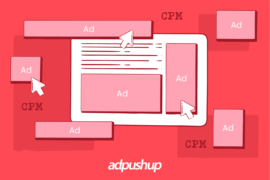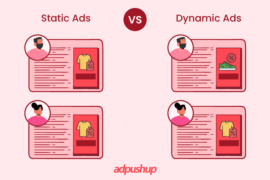The world will have 3.8 billion mobile users by 2021. This is a staggering number and holds the opportunity for publishers to earn additional revenue through mobile web monetization.
Here are some more facts about mobile advertising:
- 80% of users used mobile devices to search the internet in 2019
- An average user checks their phone 47 times a day
- An average user spends 50% of their time on a mobile device than a desktop
Mobile is creating a market of its own and advertisers are highly interested in it. Likewise, we see publishers focusing on mobile inventory as they do for desktop.
In this blog post, we will provide publishers with a perspective to capitalize on the trend of mobile advertising, see its benefits and drawbacks, and best practices.
State of Mobile Advertising
The good news is that more and more internet users are adapting to a mobile environment. The mobile-first approach for designing creatives or websites is being preferred to get the maximum out of one’s business.
According to IAB, mobile ad spending in the US was estimated to reach $70 billion in 2018. This was a 200x increase since 2008–a phenomenal rise.
The industry is recognizing this too. The graph by Statista shows that mobile ad spending will surpass desktop programmatic ad spend by 2023.

Desktop vs. Mobile
Another important point to discuss is whether publishers should concentrate on optimizing for a mobile environment or not. Through our in-house data, we found out that publishers should focus on mobile web monetization just as much as desktop.
| Category | Mobile | Desktop |
| User Engagement | Bounce rate is higher because users are quickly switching between tabs. | Bounce rate is lower because users take their time to read and research. |
| Ad Block Rates | Adblocking is lower (around 15%) | Adblocking is high (around 40%) |
| Ad Spends | Programmatic ad spend is 48%. Expected to be 51% by 2023. | Programmatic ad spend is 52%. Expected to be 49% by 2023. |
| Tracking | Offers location tracking, hence better targeting | Similar to mobile web except for very limited location tracking |
Also Read: Desktop vs. Mobile: A Comparison of UX, Ad Blocking, and Ad Revenue
Benefits of Mobile Web Monetization
Accessibility
In-app ads require users to go the extra mile and download mobile applications. As compared to the web, this is an extra step that is not required in a browser. Moreover, responsive ads adjust ads according to screen sizes, hence eliminating the dependency on mobile screen sizes.
Increased Targeting
Almost everyone uses a mobile browser to surf the internet if they use a phone. This allows increased targeting as their shopping and browsing habits are key to contextual targeting. However, in in-app monetization, this is not possible, hence giving an edge to the mobile web.
Low Maintenance
Publishers generally have to not spend additional time optimizing their inventory, unlike in-app monetization where ad sizes need constant changes according to device requirements. In mobile web advertising, responsive ads take care of device peculiarities and render publishers with more time to experiment with other things such as ad formats.
Top-Performing Ad Formats and Ad Sizes
Now that we have made a compelling case for mobile web monetization, let’s see which ad formats and sizes are most suitable.
Mobile Banner Ads
Standard banner ads are probably the most popular ad format to exist, be it desktop and mobile. They’re easy to use, offer guaranteed conversion to some extent, and can be optimized by the right ad placements.

The best part about mobile banner ads is that even the smallest of publishers can get started with them. Even premium publishers still use standard banner ads. Such is the flexibility offered by these ads.
Most Popular Mobile Banner Ads
- Mobile Leaderboard: 320*50
- Medium Rectangle: 300*250
- Large mobile banner: 320*100
Interstitial Ads
These ads pop-up on the screen when switching between two web pages or apps. In some cases, they could be intrusive and users might look for the close button. But if optimized right, these ads can be a high source of revenue for their high viewability.
These ads should be implemented with caution as publishers can often get penalized. Hence, it is best to follow the best practices for avoiding penalties.
Also Read: Interstitial Ads: Best Practices For Publishers
Some common ad sizes for interstitial ads are 320*480 (most popular) and either 320*50 or 300*50. Most publishers stick to 320*480 but there’s no harm in experimenting with other sizes.
Video Ads
Publishers’ concerns about page load time when it comes to mobile video ads are not unfounded. Video ads’ creative can be quite heavy and eventually backfire by hurting revenue.
However, it is important to note that despite these challenges, mobile video ads are one of the fastest-growing ad formats. According to eMarketer, mobile video ad spending will reach $25 billion by 2022.
Also, both outstream and in-stream video ads register maximum yield for publishers. To start with, publishers can partner with their ad network that provides outstream ads as a service.
Rich Media Ads
Rich media ads, as the name suggests are ads that make use of rich and interactive media. They often combine images, videos, and other forms of media to garner attention from a user. The only downside is that they can be heavy in file size. Google offers rich media ads in its Display Network under Lightbox ads.
Popular rich media ad sizes for smartphones include 600*500 and 320*480.
Also Read: What Are Rich Media Ads: The Complete Guide For Publishers
Mobile Native Ads
Native advertising is a subtle form of advertising where ads are designed to blend with the content. This minimizes user distraction and offers high ad viewability.
Users often engage with a native ad without even realizing that it was an advertisement in the first place. That’s the kind of viewability that native ads offer.
Publishers, however, must adhere to using these ads with responsibility. The key lies in using ‘Promoted’ or ‘Sponsored’ tags to help users differentiate between the content and these ads.
Also Read: The Top Mobile Ad Sizes and Formats for Increased Viewability
Best Practices
Use AMPHTML Ads
Google’s AMPHTML technology makes use of AMP and HTML, thus offering fast ad loading, which increases the chances of users noticing ads. Publishers can get started with these ads by partnering with a vendor that offers AMPHTML ads. Also, AMPHTML ads used with header bidding are a powerful combination that publishers must experiment with.
Prioritize Sticky Ads

Sticky ads perform well for mobile as they offer high viewability and are in the user’s viewpoint throughout their dwell time. Since mobile screens can hold only limited content, sticky ads do not ruin the user experience. Publishers can collaborate with their ad networks that offer mobile sticky ads in their ad stack.
A/B Testing
Publishers must consistently test their ad placement to get the maximum revenue out of their mobile ad inventory. Since the bounce rate in the mobile web is high, A/B testing can help in combating common issues such as banner blindness, wrong ad layouts, etc. Comparing ad units also helps publishers in enhancing user experience and improving eCPM.
Page Load Time Optimization
We’ve already discussed that the bounce rate is higher in mobile phones. Now imagine if the page doesn’t load quickly, the user will be likelier to switch to another page. This is why publishers must optimize for reducing page load time.
Also Read: 5 Quick Optimizations to Help Reduce Page Latency
Deploy Header Bidding
Increasing demand never hurts anyone, which is why publishers must deploy header bidding in their ad stack to maximize incoming demand. With demand pouring in for various available ad units, publishers can get maximum possible revenue from the limited interaction time users offer to mobile web pages.
Content is Key
Apart from optimizing ad placements, publishers must never deliver poor content. If the content continues to engage users, there is a higher chance of them noticing and interacting with ads.
Final Thoughts
A lot can be said about mobile web monetization as it is one of the fastest-growing trends in the ad tech industry. As mobile phones become cheaper and easily available, publishers must utilize this opportunity to embrace this change.
The key lies in testing consistently and using a data-driven approach to utilize your mobile ad inventory to its full potential.

Shubham is a digital marketer with rich experience working in the advertisement technology industry. He has vast experience in the programmatic industry, driving business strategy and scaling functions including but not limited to growth and marketing, Operations, process optimization, and Sales.







